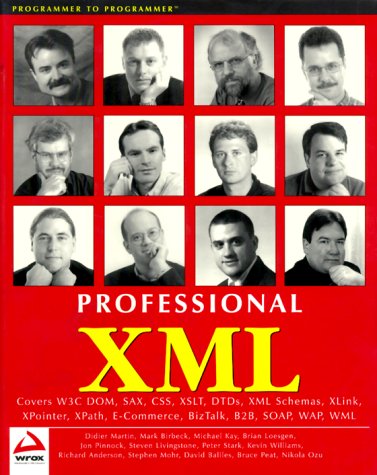XML is making an impact on almost every aspect of programming. It was designed from the start as a markup language that combines power and flexibility, with an easy to learn syntax. Developed as an open, extensible, self-describing Language, XML is a W3C standard that allows you to share data across applications, platforms, and the Internet. Expertly written, lucid, practical, and authoritative, Professional XML focuses on real world applications that use XML as an enabling technology. It presents good design techniques, and shows how to interface XML-enabled applications with web applications and database system. It explores the frontiers of XML and previews some nascent technologies. Whether your requirements are oriented toward data exchange or visual styling, this book will cover all the relevant techniques. Who is this book for? Professional XML is for anyone who wants to use XML to build applications and systems. Web site developers can learn techniques to take their sites to the next level of sophistication. Programmers and software architects can learn where XML fits into their systems and how to use it to solve problems in application integration. What does this book cover? - Detailed explanation of XML syntax with practical example - Extensive coverage of XML-related W3C specifications - How to process XML documents using the W3C DOM and SAX - Displaying XML using CSS, XSL and WML - Manipulating document structures using XSL - How to create effective models for your data when creating markup languages - How to interface XML-enabled applications with web applications and databases - Introduction to WAP, the Wireless Application Protocol
XML--eXtensible Markup Language--is capable of rendering all data transfer and display OS and application agnostic. It's a self-documenting meta-language (used to describe data) implemented as a sub-set of SGML. As the authors of
Professional XML explain, to use XML you first define an XML "vocabulary" suitable for your purpose. There are already vocabularies suitable for molecular modelling, commercial data exchange, legal and medical documents and much more. A vocabulary definition is contained in a DTD (Document Type Definition). The authors justify the need for the XML meta language, cover usage and XML document handling via DOM, Document Object Modelling. They don't spare blushes either, freely acknowledging XML problems such as the already perceived need to move from DTDs to the more elegant, XML based Schemas.
While conceptually simple, XML is tricky to implement well in data structures and XML parsers, not least because it's a moving target. The authors cover a wide range of ways to use and implement XML with real-world examples--including heavy coverage of the SAX XML API implemented in Java--but what comes through most clearly in the 1,150 pages of Professional XML is XML's lack of maturity. This is unsurprising: W3C only nailed down the XML 1.0 specification in February, 1998. There is, though, no doubt about the need for, and importance of, XML in a networked world. Whether you are developing for Web or business-to-business applications, you need to understand XML. Professional XML meets this need. --Steve Patient
